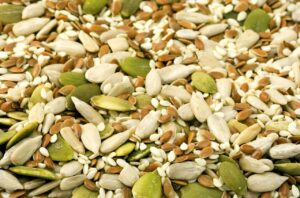
Fiber’s a mysterious nutrient. Most of us believe it’s healthy to eat dietary fiber and yet we aren’t sure where to find it at the grocery store.
Fiber is a mysterious nutrient, isn’t it? We hear that we should consume it every day and some people realize its importance in probiotics and nurturing a healthy gut. There are hundreds of ‘dietary fiber target’ foods lurking in every grocery store and yet many of us feel overwhelmed and confused. Where are they hiding? And, how much do I need? Here are some answers for you:
While strolling through your grocery store, get to know these locations as ‘dietary fiber targets.’
Finding Fiber – Fruits and Vegetables
All fruits and vegetables are high in fiber, in general, even though there is variation from fruit-to-fruit and vegetable-to-vegetable. The fiber in a specific fruit or vegetable doesn’t change from fresh to frozen to canned to dried, so choosing any of them is a good decision.
The Bottom Line: At the grocery store, save room in your cart for fruits and vegetables in all forms – fresh, frozen, canned, and dried. And, don’t miss the dried or canned beans such as kidney, black beans, garbanzo beans, and lentils.
Finding Fiber – Seeds and Nuts
All seeds and nuts are naturally full of fiber and this makes them excellent choices. Specific seeds like pumpkin and sunflower are not identical in fiber content, and yet all are ‘dietary fiber targets.’ Nuts such as almonds, walnuts, peanuts, and more, along with nut butters, all contribute fiber to our meals and snacks, too. So, choose a variety you like, or mixed nuts, each shopping trip to make sure you are consuming fibrous foods day-to-day.
The Bottom Line: At the grocery store, save room in your cart for seeds and nuts, and seed and nut butter – all kinds.
Finding Fiber – Bread, Cereal, and Crackers
Not all bread is high in fiber. And, it may surprise you to learn that not all brown colored bread is high in fiber, nor high in quality in general. The grain ingredients of bread, cereal, and crackers are key to whether it’s a ‘dietary fiber target.’ Here’s why…
This is a helpful diagram of a whole grain, showing the bran, endosperm, and germ. For fiber content, the outer layers, or bran, are highest. So most bread, breakfast cereal, and crackers that include the outer bran of one grain or multiple grains are good sources of fiber. When reading through the ingredient list, be on the lookout for the word ‘whole’ in front of a grain word such as wheat or oats. Be sure to read the fine print, too, because there may be added sugars that you are trying to avoid. In the case of breakfast cereal, a typical brand of bran flakes includes healthful fiber along with 1-2 teaspoons (4-8 grams) of added sugars per serving. Oatmeal is a wise choice with several grams of fiber per serving and no added sugars as are most brands of whole wheat biscuit-type cereal. As surprising as it sounds, some brands of crackers have added sugars along with their healthful fiber, so be sure to read and compare the brands’ labels carefully.
The Bottom Line: At the grocery store, save room in your cart for unrefined, whole grain bread, cereal and crackers.
Finding Enough Fiber
A healthy, daily consumption of dietary fiber is 25-30 grams. This helps put it all in perspective because it allows each of us to define our ‘dietary fiber target’ foods. For example, if I divide the day into 3 major meals and 2 small snacks then I’ll need 7 grams in each major meal (7 grams x 3 = 21) plus 2-3 grams in each small snack (2-3 grams x 2 = 5) — a total of 26 grams of dietary fiber in one day. Do your own personal math for dietary fiber and see how it comes out. And, always include some of these: fruits, vegetables, beans and lentils, seeds, nuts, whole grains (ex. brown or wild rice, quinoa, millet, farro, barley,) whole grain bread, whole grain cereal, and whole grain crackers. For a start, here’s a free download of 6 Mediterranean Nutrition Grocery Tips.
What foods do you include on your grocery shopping list to make sure you’re consuming enough dietary fiber?